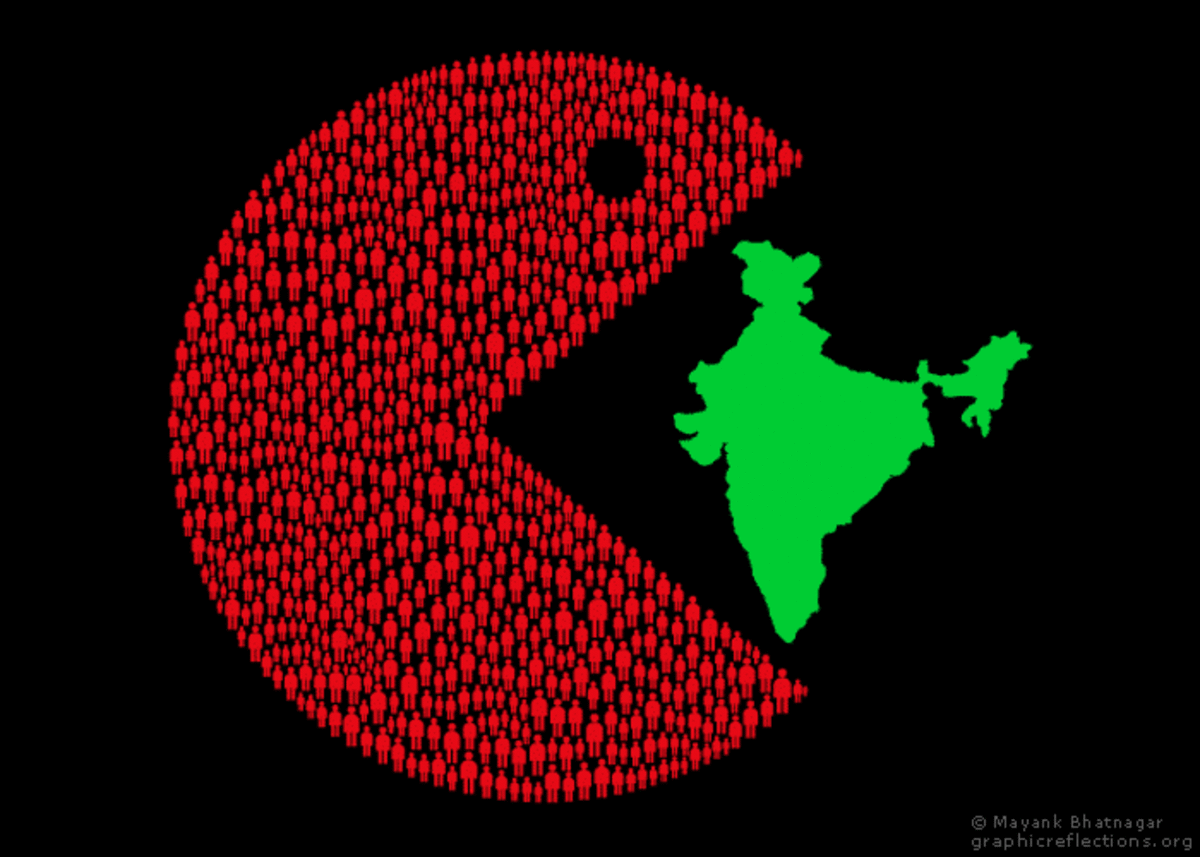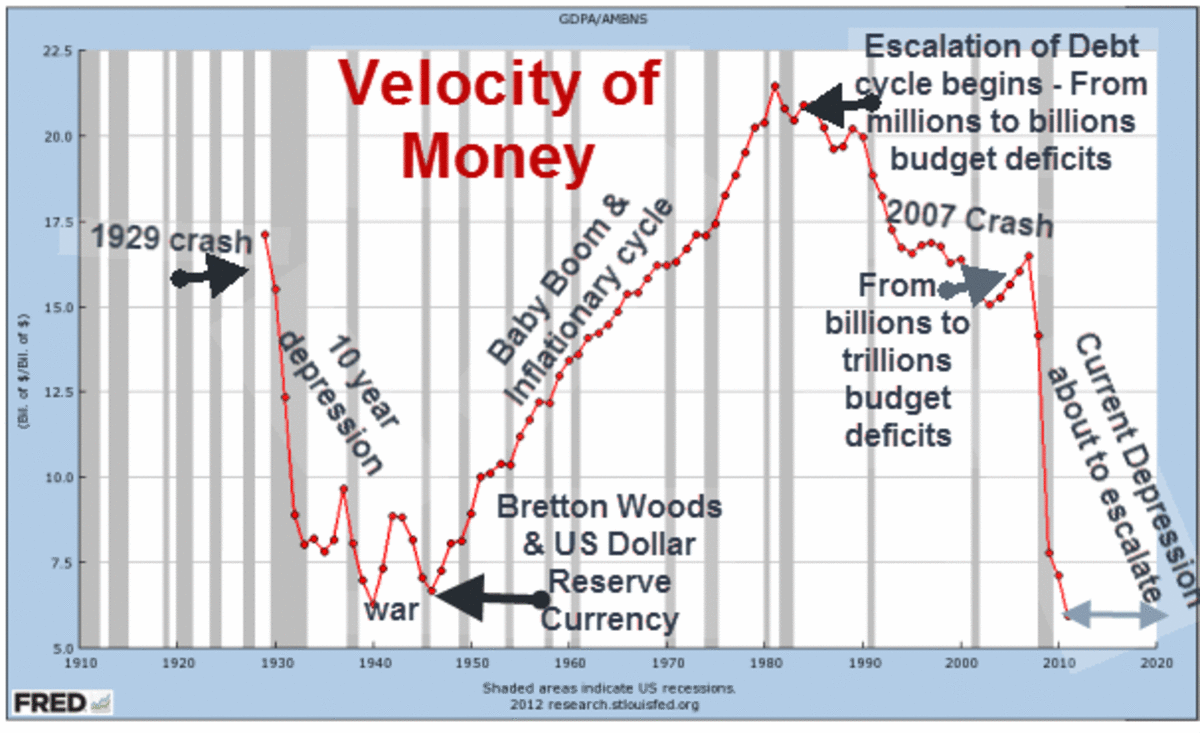The World Is Explodin' (Population Growth)
Too Many People

Country Trouble Hotspots
The World population is exploding. We hear this all before. The problem is if we hear it enough times, we become nonreactive to it. We know the population is increasing but we also know the growth rate of the world is decreasing. Should we still be concern? In many ways, yes!
The difficulty with understanding the population situation is the math. Yes, that dreaded word, mathematics. It is base on the principle of exponential growth. Interesting enough, exponential growth is not found in nature. Nature, because it has its own built in balance and checks, (predators and prey is a good example), rarely exhibits explosions in population growth. There are exceptions due to man’s interference with nature. Introducing a species not native to that country with no known predators is a typical example. Rabbits multiplying rapidly in Australia is a classic example.
Man has introduce exponential growth in many of the things he has created: national debt, energy consumption, mass production of products, depletion of our natural resources, rising costs of houses, food, fuel, etc.
I will try to keep the mathematical principles simple. Basically, exponential growth feeds upon itself – it is a positive feedback system. The more we have, the faster it grows. The amount we have is called the base. It is what we start off with.
We will look at population growth in countries (a future hub will look at cities -- worldwide). These are the alarming facts we must be aware of. These are all mathematical sound facts thus indisputable.
FACT #1 – The bigger the base is, the faster the population will increase.
FACT #2 – The amount of increase in population plays a far greater role in growth.
FACT #3 – Even as the world’s population growth decreases, the number of people will continue to increase yearly.
FACT #4 – The world’s population growth rate is 1,2%. It doesn’t sound like much but just the sheer addition of people added every year offsets the reduced growth rate. In 1963, the world’s growth rate was 2.1% and the annual increase was 69 million people. In 2003, the world’s growth rate decreased to 1.26% but the annual increase was 79 million! The growth rate now is 1.17%, and the annual increase hasn’t changed. This is because the base population continues to climb and is a major factor in determining annual increase. The population of the world was 3.2 billion in 1963. Fourty years later (2003), the world’s population almost double – to 6.3 billion. Despite a decrease in growth rate (by 0.79%), the annual increase in the world’s population from 1963 to 2003 was 10 million. By 2010, the growth rate dropped by 0.09% but the annual increase didn’t change. What did change was the total world’s population – the world’s population is now 6.931 billion!
FACT #5 – Only 11 countries contributed to 63.5% of the world’s annual increase. Out of 79 million people, this would be 44.5 million. The eleven countries are (in order of population increase): India, China, Pakistan, United States, Nigeria, Indonesia, Ethiopia. Brazil, Congo(Dem. Rep. of), Bangladash, and the Philippines. India’s population increase is double that of China’s. This is because India’s growth rate is much greater that China’s. India and China contributes more than 50% of the annual increase by these 11 countries. The United States’ annual increase is contributed mainly by immigration while the others are by the birth rate. All of these countries have large base populations (at least over 70 million people). As far as growth rates go, China has the lowest (0.66%) while two have growth rates over 3% (Ethiopia and Democratic Republic of the Congo)
FACT #6 – Thirty-one countries contributed to more than 80% of the annual increase. The only developed country in this list was the United States.
FACT #7 – The world’s population is increasing 217,096 per day! India – 50,000, China – 24,000, Pakistan – 9,400, United States – 8,200. The top eleven countries are increasing at least 5,000 people every day. Fourty-two countries have daily increases of more than one thousand people.
FACT #8 – The eleven fastest growing countries also have a total population of nearly 4 billion people (about 59% of the total world’s population)
FACT #9 – In order for the world “to put the brakes on” the increase in world’s population, the world’s growth rate must decrease by at least 0.075% for every decade.
FACT #10 – 97% of the projected increase in the world’s population is to take place in the developing countries. The main reason is that a large percentage of people are under 15 years old – 33%. The developed countries have only 18%.
FACT #11 – Every time your heart beats, 2.5 babies are added to the world’s population.
FACT #12 – The replacement rate is the number of children needed to replace themselves. The replacement rate is 2.1. Will this stop population growth? NO! Because the future parents are still alive! If each of today’s couple have 2.1 children and their children have 2.1 children, the world’s population would still grow for another fifty years or more (assume death rates don’t change).
FACT #13 – The doubling time for countries is easy to calculate if you know the growth rate. The doubling time is the time for a country’s population to double. Just take the growth rate and divide it into 70 and the result will be its doubling time. Liberia has the fastest growth rate of any country –4.5%. 70/4.5 = 15.6 years. Liberia’s population (presently at 3.441 million) will double in 15.6 years (to 6.882 million). It will double again (if its growth rate doesn’t change) in the next 15.6 years to 13.764 million (31.2 years later). The next fastest growth rate is 3.9% held by Afghanistan. Its population is 33.609 million. It will double its population within 18 years. By the year 2029, Afghanistan’s population would be 67.218 million. The daily increase now is 2400 people but the daily increase will also double by 2029, increasing by 4800 per day.
FACT #14 – Thirty-nine years later, it will be 2050. Any growth rate greater than 1.75% will double their population within this period. Here is a list of countries with a base population 20 million or more and growth rates greater than 1.75%. Also given is their population in 2050.
See Appendix A Below.
To see a list of countries with base populations greater than 20 million but growth rate less than 1.75%, see Appendix B below.
FACT #15 – Population equivalents of China (1.33 Billion) is added every 16 years!
FACT #15 -- Basically, a country shouldn’t have a growth rate more than 0.75% (doubling time of 93.3 years) to maintain some kind of population control. But ideally, any sustainable growth should be no more than 0.3%. This way, the government would be provide the basic services their people need (utilities, roads, food, water, shelter).
FACT #16 – A country with a population 10 million larger than another country must decrease their growth rate by 0.33% to reach identical populations within 40 years.
FACT #17 – Population equivalents of China (1.33 Billion) is added every 16 years!
FACT #18 – The regions of the world with the greatest population growth rates are the Moslem countries, Southern Asia, Eastern Asia, Middle East, Eastern Africa, Central and Western Africa.
FACT#19 – The fastest growing areas occurred in Africa and Moslem countries.
FACT #20 – Four other countries should be noted: Malawi, Rwanda, Burundi and Somalia. All four have rapid growth rates: from 2.38% to 3.28%. Rwanda and Burundi are very small countries located in Central Africa and thus are very densely populated.
FACT #21 – France is the fastest growing country in Europe with 965 people every day.
FACT #22 – The fastest growing country in Central America is Guatemala at 753 people every day.
FACT #23 -- Fastest growing former Soviet Union republic is Uzbekistan at 711 people every day.
FACT #24 – Other noted countries are Canada and Australia at 752 and 699 people every day respectively.
Appendix A
Country Pop (2011) G.R. Doubling time Pop(2050) **Daily Inc.
(in millions) (in years) (in millions)
Congo (Dem. Rep) 68.693 3.21% 21.8 248.054 6041
Ethiopia 85.237 3.21% 21.8 307.796 7496
Yemen 23.823 3.45% 20.3 94.694 2252
Madagascar 20.654 3.00% 23.3 68.574 1698
Kenya 39.003 2.69% 26.0 114.393 2874
Afghanistan 33.610 2.63% 26.6 96.238 2422
Uganda 32.370 2.69% 26.0 94.939 2386
Iraq 28.946 2.51% 27.9 79.000 1991
Nigeria 149.229 2.00% 35.0 332.115 8177
Sudan 41.088 2.14% 32.7 96.710 2409
Tanzania 41.049 2.04% 33.8 92.830 2294
Cote d’Ivoire 20.617 2.13% 32.9 48.333 1203
Syria 20.178 2.13% 32.9 47.304 1178
Cameroon 18.879 2.19% 32.0 45.334 1133
Pakistan 182.354 1.95% 35.9 404.345 9416
Philippines 97.977 1.96% 35.7 214.591 5261
Saudi Arabia 28.687 1.85% 37.8 60.126 1454
Ghana 23.832 1.88% 37.2 50.553 1228
Mozambique 21.669 1.79% 39.1 44.340 1063
** The daily increase is present values. By the year 2050, most of the increases will double to quadruple. To calculate the daily increase for 2050 just divide the pop for 2050 by pop for 2011 and multiply by the present daily increase.
Appendix B
Here is list of countries with daily increase of 1000 or more, with growth rates less than 1.75%, but not listed above:
India 1,166.079 1.55% 45.2 2,168.657 49,518
China 1,338.613 0.66% 106.1 1,743.046 24,205
United States 307.212 0.98% 71.4 454.655 8248
Indonesia 240.272 1.14% 61.4 379.089 7504
Brazil 198.739 1.20% 58.3 321.177 6534
Bangladash 156.051 1.29% 54.3 261.439 5515
Egypt 83.083 1.64% 42.7 160.107 3733
Mexico 111.212 1.13% 61.9 174.764 3443
Turkey 76.806 1.31% 53.4 129.708 2757
Vietnam 86.968 0.98% 71.4 128.707 2335
Columbia 45.644 1.38% 50.7 79.271 1726
Iran 66.429 0.88% 79.5 94.456 1602
Niger 15.306 3.68% 19.0 66.703 1543
Morocco 34.859 1.48% 47.3 63.011 1413
Burkino Faso 15.746 3.10% 22.6 54.409 1337
Malaysia 25.716 1.72% 40.7 51.168 1212
Argentina 40.914 1.05% 66.7 62.270 1177
Algeria 34.178 1.20% 58.3 55.234 1124
Thailand 65.905 0.62% 112.9 84.455 1119
Venezuela 26.815 1.51% 46.4 49.056 1109
Myanmar 48.138 0.78% 89.7 65.764 1029
Senegal 13.712 2.71% 25.8 40.539 1018
Nepal 28.563 1.28% 54.7 47.661 1002
Notice that China and Thailand have relatively low growth rates compared to the rest. China has the one child policy and Thailand’s government has a very effective birth control and planned parenthood education program.
Moslem Countries
Country Population(2011) Population(2050) Pop. Increase
Indonesia 240.272 379.089 138.817
Pakistan 182.354 404.345 221.991
Bangladash 156.051 261.439 105.388
Egypt 83.083 160.107 77.024
Iran 66.429 94.456 28.027
Turkey 76.806 129.708 52.902
Sudan 41.088 96.710 55.622
Algeria 34.178 55.234 21.056
Morocco 34.859 63.011 28.152
Iraq 28.946 79.000 50.054
Afghanistan 33.610 96.238 62.628
Malayasia 25.716 51.168 25.452
Saudi Arabia 28.687 60.126 31.439
Yemen 23.823 94.694 70.871
Syria 20.178 47.304 27.126
Niger 15.306 66.703 51.297
Burkino Faso 15.746 54.409 38.663
Senegal 13.712 40.539 26.827
Nigeria 149.229 332.115 182.996
Total: 1,120.844 2,566.395 1,445.551
Growth Rate: 2.07%
Doubling Time: 33.8 Yrs.
South Asia
Country Population (2011) Population (2050) Pop. Increase
India 1,166.079 2,168.657 1,002.578
Nepal 28.563 47.661 19.098
Bangladash 156.051 261.439 105.388
Pakistan 182.354 404.345 221.991
Afghanistan 33.610 96.238 62.628
Total: 1,566.657 2,978.340 1,411.683
Growth Rate: 1.61%
Doubling Time: 43.5 Yrs.
Eastern Asia
Country Population (2011) Population (2050) Pop. Increase
China 1,338.613 1,743.046 404.433
Vietnam 86.968 128.707 41.739
Thailand 65.905 84.455 18.550
Myanmar 48.138 65.764 17.626
Philippines 97.977 214.591 116.614
Indonesia 240.272 379.089 138.817
Malayasia 25.716 51.168 25.452
Total: 1,903.589 2,666.820 763.231
Growth Rate: 0.84%.
Doubling Time: 83.3 Yrs
Middle East
Country Population (2011) Population (2050) Pop. Increase
Iran 66.429 94.456 28.027
Iraq 28.946 79.000 50.054
Turkey 76.806 129.708 52.902
Syria 20.178 47.304 27.126
Saudi Arabia 28.687 60.126 31.439
Yemen 23.823 94.694 70.871
Egypt 83.083 160.107 77.024
Total: 327.952 665.395 337.443
Growth Rate: 1.77%
Doubling Time: 39.5 Yrs.
Eastern Africa
Country Population (2011) Population (2050) Pop. Increase
Sudan 41.088 96.710 55.622
Ethiopia 85.237 307.796 222.559
Kenya 39.003 114.393 75.390
Uganda 32.370 94.939 62.569
Tanzania 41.049 92.830 51.781
Mozambique 21.669 44.340 22.671
Madagascar 20.654 68.574 47.920
Total: 281.070 819.582 538.512
Growth Rate: 2.68%
Doubling Time: 26.1 Yrs.
Central and Western Africa
Country Population (2011) Population (2050) Pop. Increase
Senegal 13.712 40.539 26.827
Cote Ivoire 20.617 48.333 27.716
Burkino Faso 15.746 54.409 38.663
Niger 15.306 66.703 51.297
Nigeria 149.229 332.115 182.886
Ghana 23.832 50.553 26.721
Cameroon 18.879 45.334 26.455
Dem. Rep. Of the Congo 68.693 248.054 179.361
Total: 326.014 886.040 559.926
Growth Rate: 2.50%
Doubling Time: 28.0 Yrs.








